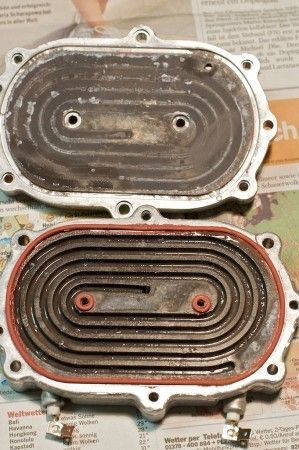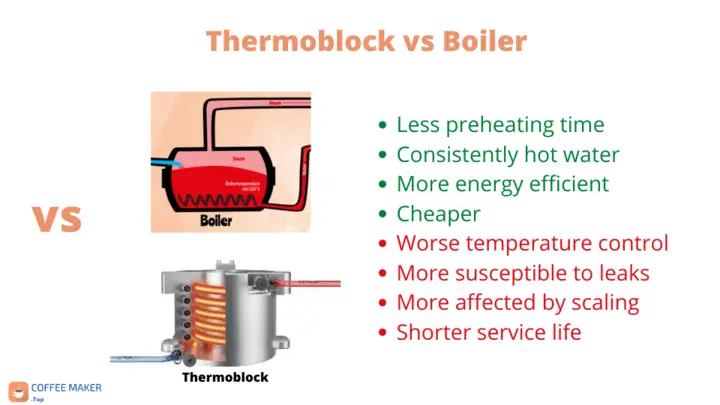The Thermoblock system is a heating method that uses internal tubes to heat the water quickly. The speed of the water flow is important to reach the exact temperature and avoid cooling.
Unlike traditional boilers, the Thermoblock does not store water but draws it directly from the tank. When the coffee machine is switched on, the Thermoblock heats up within 20 to 30 seconds, which raises the water’s temperature through the pipes quickly.
In the following image, we can see what a Thermoblock system looks like inside:

Advantages of the Thermoblock System in coffee machines
These are some of the advantages of the Thermoblock system in a coffee machine:
- The Thermoblock system consumes little energy and heats only the necessary water for each coffee.
- Due to its heating speed, it allows you to make a cup of coffee in the shortest possible time.
- As it does not accumulate hot water inside, it prevents it from acquiring strange odours or flavours due to overheating if it is not used for several days.
Disadvantages of the Thermoblock system in coffee machines
Although the Thermoblock system offers several advantages, it has some potential drawbacks in coffee machines. I will mention some of them:
- Temperature variation: The water temperature may not remain as stable as in traditional boilers. There may be a slight variation in water temperature during the brewing process, which could affect the consistency in taste and extraction of the coffee.
- Limescale build-up: Thermoblocks may be more prone to limescale build-up due to the heating speed and direct contact of the water with the internal components. When a Thermoblock is saturated with limescale, the water flows more slowly, and the coffee extraction will not be correct.
See this article: My coffee machine does not heat the water.
Differences between the boiler system and Thermoblock system
Here are some of the main differences between the boiler and Thermoblock systems in a coffee machine. Both systems have their advantages and disadvantages, and the choice will depend on your specific preferences and needs:
- Water storage: In a traditional boiler, a certain amount of water is stored and kept hot for later use. In contrast, in the Thermoblock system, water is not stored but is drawn directly from the tank when needed.
- Heating time: The traditional boiler can take several minutes to reach the right temperature. Also, those with a double boiler (for water and steamer) take even longer. On the other hand, the Thermoblock system heats up within 20 to 30 seconds, allowing for quick water heating.
- Temperature control: The traditional boiler system allows more precise water temperature control, as it can be adjusted and kept constant throughout the brewing process. In the case of the Thermoblock, the temperature can vary due to the rapid and direct heating of the water in the internal tubes.
- Energy efficiency: By not requiring constant storage and maintenance of hot water, energy can be saved with the thermoblock compared to a boiler system coffee machine.
- Applications: Traditional boilers are commonly found in espresso or large-volume coffee machines, which require considerable quantities of coffee to be brewed at a time. The Thermoblock system is more common in coffee pod machines.

Which coffee machines use Thermoblock and why?
As I mentioned before, one of the advantages of the Thermoblock is the speed with which it heats the water, even if its temperature control is not the best possible.
For this reason, the Thermoblock system is most common in coffee pod machines, and the boiler is most common in espresso and superautomatic coffee machines, where the emphasis is on quality and not speed.
Boilers in espresso machines
Most group espresso machines have a dedicated boiler unit for steam because when heating milk, it is not so important that the temperature is constant, but it should be immediately high.
However, in early espresso machines, the same boiler was used for water and steam, which made them more complicated and delicate.
Over time, espresso machines developed more efficient heating and steam systems, including heat exchanger + boiler systems and double boiler systems (one for water and one for steam).